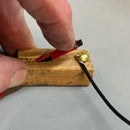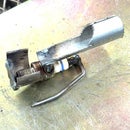Introduction: Cove Cuts on a Radial Arm Saw
This is a Google Sketchup drawing of picture frame stock made from cove molding that I have made on my radial arm saw. No special cutters are required.
Step 1: Basic Setup of the Saw
A cove cut pushes the work piece into the side of the blade rather than the front edge and reproduces the circular profile of the blade in the workpiece.
Cove cuts can be made on a table saw. Here you see the basic setup on a radial arm saw. The workpiece is guided by two fences with one on each side of the workpiece. The two fences blend into the background in the photo, so I outlined their working edges with red lines.
In order to achieve a smaller radius cut, I used the 7 1/4 inch blade from my circular saw rather than the usual 10 inch blade normally used on my radial arm saw. The motor is tilted to about 45 degrees so the teeth bite into the wood more easily as it is pushed toward the saw. Notice that the motor has also been rotated clockwise a few degrees (as viewed from above the motor) so that the yoke is no longer fully in the crosscut position. The spoon handle lever that locks the yoke (yellow arrow) was loosened to allow the motor to rotate and is again locked to hold the motor in position.
Cove cuts can be made on a table saw. Here you see the basic setup on a radial arm saw. The workpiece is guided by two fences with one on each side of the workpiece. The two fences blend into the background in the photo, so I outlined their working edges with red lines.
In order to achieve a smaller radius cut, I used the 7 1/4 inch blade from my circular saw rather than the usual 10 inch blade normally used on my radial arm saw. The motor is tilted to about 45 degrees so the teeth bite into the wood more easily as it is pushed toward the saw. Notice that the motor has also been rotated clockwise a few degrees (as viewed from above the motor) so that the yoke is no longer fully in the crosscut position. The spoon handle lever that locks the yoke (yellow arrow) was loosened to allow the motor to rotate and is again locked to hold the motor in position.
Step 2: The Basic Cove Cut
A cove cut is made by a series of light cuts until the desired profile is achieved. On a radial arm saw, lower the arm about 1/16 to 1/8 inch for each pass. A lighter cut fed very slowly through the saw will give a smoother cut. This is especially important at the end of the process. Still, the saw tears at the grain and leaves fine saw marks. Quite a bit of hand sanding is needed to make a nicely finished piece.
Step 3: Remove Excess
To make picture frame stock from the cove cut piece, set your saw to remove the sections in red.
This is an acceptable way to make picture frame molding, but there are also many things that can go wrong. Each cut requires a great deal of precision. If the wood chatters or a tough section of grain makes the workpiece jump a little, a gouged out section can appear and damage your good efforts. Still, there are times when such a piece of picture frame molding works just fine.
This is an acceptable way to make picture frame molding, but there are also many things that can go wrong. Each cut requires a great deal of precision. If the wood chatters or a tough section of grain makes the workpiece jump a little, a gouged out section can appear and damage your good efforts. Still, there are times when such a piece of picture frame molding works just fine.
Step 4: Make a Bowl
A variation on a cove cut is cutting out a bowl recess in a piece of wood. I used pusher sticks to keep my hands away from the spinning blade. See the red arrow. This pusher stick holds the workpiece down firmly against the work table. See the green arrow. This pusher stick is used to rotate the workpiece 360 degrees in steps. If the position of the saw leaves a button of wood in the center, just remove it with a chisel at the end.
What you cannot see in the photo is a pin under the workpiece about which the workpiece rotates. (See the next step.)
I needed to make four of these. They were to become the top layer in a stack of three pieces. I needed to make supports that raise someone's bed a few more inches above the floor. He has had two knee replacements and will have trouble getting in and out of a bed at the normal height. The raised bed will make it easier for him. The bowl-shaped indentations will provide a nesting place for the bed's casters.
What you cannot see in the photo is a pin under the workpiece about which the workpiece rotates. (See the next step.)
I needed to make four of these. They were to become the top layer in a stack of three pieces. I needed to make supports that raise someone's bed a few more inches above the floor. He has had two knee replacements and will have trouble getting in and out of a bed at the normal height. The raised bed will make it easier for him. The bowl-shaped indentations will provide a nesting place for the bed's casters.
Step 5: The Pin
I clamped an old piece of particle board to the saw's work table. In this particle board I drilled a hole for a 1/2 inch dowel pin that serves as the pin about which the workpiece rotates. I drilled a corresponding hole in the bottom of the work piece. Then I positioned the lowest portion of the saw blade over the center of the dowel pin as precisely as I could.
Step 6: What the Saw Manual Suggests
I bought an additional manual on using my radial arm saw. It gave a procedure for making a bowl cut, but I saw some potential problems with it. The first step was to lift the indexing pin and hold it lifted, which is not an easy task even when a sharp saw blade is not spinning at 3000 rpm a few inches below. The second part of this suggested operation is to loosen the spoon handle lever (green arrow). If it is loosened fully, the yoke and motor have some undesirable movement that will result in uneven cuts. The spoon handle lever can be loosened just enough to allow the motor to swivel, but this is an uncertain process. I would rather have things locked down so nothing is left to chance. There is one more part of the suggested process. See the next step.
Step 7: The Rest of the Suggested Process
With the yoke a bit loose and the saw running, the operator is to lower the arm so the blade begins to cut on the workpiece. Then, while still holding the indexing pin high, he is to use his other hand to swing the motor 180 degrees by grasping the end of the anti-kickback paw rod. (See the red arrow.) There is still the problem of how to hold the workpiece down on the table. Now you know why I used a dowel pin below the workpiece and pusher sticks to rotate the workpiece.
Step 8: One More Cove Cut Project
This is a cross I sometimes wear when I am leading the worship service at the church where I am the pastor. It was made with three cove cuts on each of the two pieces. I made several of these at the same time. The first step was to make a cove cut in a longer piece of wood, as in step 2. Then I cut that piece crosswise into narrower pieces. Finally I made a cove cut on the side edges of each of the narrower pieces. The two pieces of each cross are joined with a lap joint. The horseshoe nail heads are a decorative touch and have no particular meaning.





